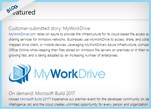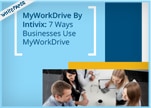Reasons Why You Need MyWorkDrive For Your Hybrid Cloud
- Access your Work Files without storing data in a public cloud
- Direct Office File Edit & Collaboration in Office Online
- Publicly share files using OneDrive integration without compromising security
- Restrict Downloads to ensure compliance while still allowing viewing and editing of documents online
- All Data Remains on your Server
Our Hybrid Cloud Solution
- Install MyWorkDrive Server Software on a Windows Web Server
- Point to Existing Shares, Users & Groups
- Access Your Files – Use our Web File Manager, Mapped Drive application or your phone to access your files
Customer Qualification Criteria
- Customer size is 50+ employees. Industries applicable: Financial, Healthcare, Government, Public Sector, Utilities & Education
- Customer usually has an investment in Microsoft Technology and Office 365
- Customer wants Hybrid Cloud Implementation with an ability to access and interact with files stored on their on-premise server
Increase User Productivity & Security
- Drive Office 365 Adoption
- Reduce Support & Training Requirements
- Eliminate VPN Security Issues
- Add Two Factor Authentication
- Single Sign On
Hybrid Cloud the best of all worlds
Hybrid cloud is a cloud computing environment that uses a mix of on-premises, colocation infrastructure, private cloud and third-party public cloud services with orchestration between all the platforms. The hybrid cloud model empowers you to protect your most valuable data on your terms; you are the one who decide where your data is stored, and how that data is protected from external and internal threats. For the purposes of this blog, hybrid cloud includes the following:
• On-premise infrastructure connected to cloud resources
• Colocation infrastructure connected to the cloud
• Managed colocation/hosting infrastructure connected to the cloud
• Cloud resources connected to other cloud resources
With the speed of business increasing every day, the one constant is change; changing business models, strategies, infrastructure, and technologies. New concepts such as AI, Analytics, Edge Computing and multiple Cloud models are opening up a sea of new opportunities. This new paradigm is forcing businesses to seek new possibilities. When businesses adopt these new, but rapidly maturing technologies, they create additional demands on the existing infrastructure. This in turn impacts your end-users and changes the way your business functions.
These ‘breakthroughs’ will enable your business to achieve competitive advantages, but will also challenge traditional ways of business growth using IT. Enterprises need ways to bridge current infrastructure with future technology investments to connect, innovate and grow. A hybrid cloud model provides the most stable infrastructure foundation for such future growth.
Reasons to deploy a hybrid cloud
The primary benefit of the hybrid cloud model is agility. The need to adapt and change direction quickly is a core principle of a digital business. Scalability and speed to market are sub-benefits of agility, crucial elements of successful IT services delivery. You might want to combine public clouds, private clouds, and on-premises resources to gain the agility you need to develop and sustain a competitive advantage.
Most Enterprises currently use a combination of public and private clouds to access, store and manipulate their data. Public clouds store enterprise data on servers owned by third-party providers, reducing maintenance and operational costs for the business. Whereas a private cloud is operated and managed in your datacenter. This means that you control the security and infrastructure, but managing these on-premise datacenters can be costly and resource intensive.
The hybrid cloud model suggests an elegant solution. Combining the advantages of all cloud models into a single entity that can merge the public cloud solution with collocation infrastructure, on-premise infrastructure and a private cloud platform. By spreading computational and data storage across all resources allowing you to optimize your environment and streamline your day-to-day tasks.
You decide what data is stored on public servers while ensuring your proprietary information is protected in your private cloud. Leveraging both public and private clouds for optimum security and maximum scalability.
Improved Security Capabilities
When you need enhanced security and ultimate control for business-critical apps and data, incorporate a private cloud. Store your most sensitive data on dedicated hardware while running your front-end applications in the public cloud — creating a seamless, agile and secure environment, while benefiting from the public cloud’s cost efficiency and on-demand scalability.
Cost Benefits
Milind Govekar, managing VP at Gartner research firm, states that “Hybrid cloud computing can maximize cost-efficiency, particularly capital expenditure, through competition and automated arbitrage.” Cost savings can be found in many hybrid cloud use cases such as temporary/burstable resources, cloud storage, data/application segmentation, and scalability needs. Additional cost-efficiency gains can come from reducing operational and maintenance expenses. Fewer on-prem servers means less energy consumption from powering and cooling the servers, reducing energy costs. Less on-prem means less to manage, which can lead to a more efficient use of staff resources.
Reduce your Total Cost of Ownership, match your cost patterns to your revenue/demand patterns and transition from a CapEx cost model, to an OpEx-based model. Hybrid cloud allows you to take advantage of emerging cloud technologies, while still retaining your legacy applications within your corporate data centers.
Risk Management
Hybrid cloud is an excellent way for a company just starting in the cloud to mitigate risk. It allows you to start testing non-critical workloads to prove the concept before moving the more critical applications in to the cloud. Beware, hybrid cloud can significantly increase the complexity of your company’s network infrastructure as well as increase security risks. It might be a good idea to use a consulting partner if you are not experienced in clouds technology. Using a hybrid cloud model can reduce the risk of vendor lock-in and create a migration path if a better opportunity comes along.
Scalability
The public cloud’s pay-as-you-go scalability, is ideal for heavy or unpredictable traffic — and can reduce IT costs. For rapidly growing companies, scaling on-prem IT infrastructure can be expensive and inefficient. With a hybrid cloud model, you can tie on-premise to the specific cloud resources you need for rapid growth, implement automation rules to instantly obtain future resources whenever/however you need them. Larger cloud providers have data centers around the world with mind-boggling hardware capacity, I.e. with hybrid cloud you have unlimited resources at your disposal, on demand.
Flexibility
Hybrid cloud enables a variety of choices as to how you are able to deliver IT services. Hybrid cloud means you can take advantage of the best advantages each delivery method has to offer (public, private, co-location, in-house, etc.) while mitigating the risks of choosing just one.
Network Performance
A common cloud issue is latency, a network issue resulting in slow or poorly performing applications. Implementing a direct connect private network hybrid cloud strategy can dramatically improve the overall user experience. When you pair hybrid cloud with load balancing you can reduce distance-based latency by insuring the infrastructure is delivered as close as possible to the end user.
However, just choosing to go hybrid cloud, doesn’t mean you are guaranteed these benefits. Depending on your company and its inherent complexities, executing your hybrid cloud vision could be a complex undertaking and is best accomplished with an experienced partner.
Now that you have data in the cloud and on premise, how are you going to access those files? MyWorkDrive allows you to access any mapped drive from anywhere safely and securely, using Microsoft Office or Office 365 you can open those files and do anything you could do sitting at your desk. Your data stays behind your firewall and only the keystrokes travel up and down MyWorkDrive’ s encrypted tunnel. None of your data is exposed to the wild. Freedom!





